Settlement in the Kearney area began in the 1830s as a stopping point on the Oregon Trail. Fort Kearny was established in 1848, and with the Union Pacific Railroad’s completion at Kearney in 1869, Kearney was founded April 11, 1871. The Burlington Railroad was completed to Kearney in 1872 and Kearney was incorporated in 1873.
Life was difficult for these early pioneers, and Catholic life was even more difficult because of the scarcity of priests to care for these souls. Sometimes months would pass without people having the opportunity to assist at the Mass.
The first settlers of this region were the Shanons, the Maolers, the Ayers, the Brookers, the Eckhouts, the Caseys, the Worels, just to mention a few of the early Catholic families.
The f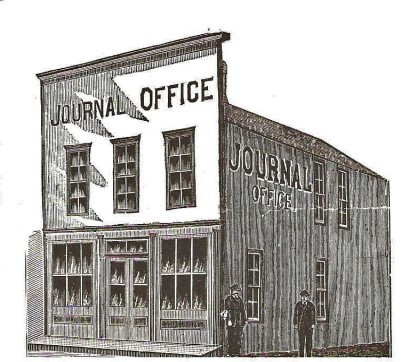 irst settlers in the region and early Catholic families made their living by farming, working in the cotton mill or on the railroad. The Catholic life was difficult because there were few priests and established parishes in easy travel distance. Months or even years would pass without the opportunity to celebrate Mass or receive communion. But with the ar
irst settlers in the region and early Catholic families made their living by farming, working in the cotton mill or on the railroad. The Catholic life was difficult because there were few priests and established parishes in easy travel distance. Months or even years would pass without the opportunity to celebrate Mass or receive communion. But with the ar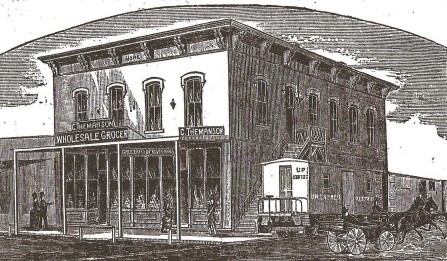 rival of the railroads, Mass was offered in Kearney fairly regularly, in an old printing shop and then in a hall over a lumber shop on Central Avenue just south of the railroad tracks. Before a parish was established, priests came from Omaha, Grand Island and Columbus.
rival of the railroads, Mass was offered in Kearney fairly regularly, in an old printing shop and then in a hall over a lumber shop on Central Avenue just south of the railroad tracks. Before a parish was established, priests came from Omaha, Grand Island and Columbus.
On June 1, 1881 Bishop James O’Connor purchased property in south Kearney, on the east side of Avenue A between 18th and 19th streets. That same year Father P.J. Boyle was appointed the first resident pastor for Kearney. He built the first rectory in 1882 and the first church was built around that time. Father Boyle was succeeded by Father Nicholas Stolz, a native of Luxemborg, in 1885. From its beginning as a mission parish, soon the parish extended to all of Buffalo County and parts of Dawson and Custer counties.
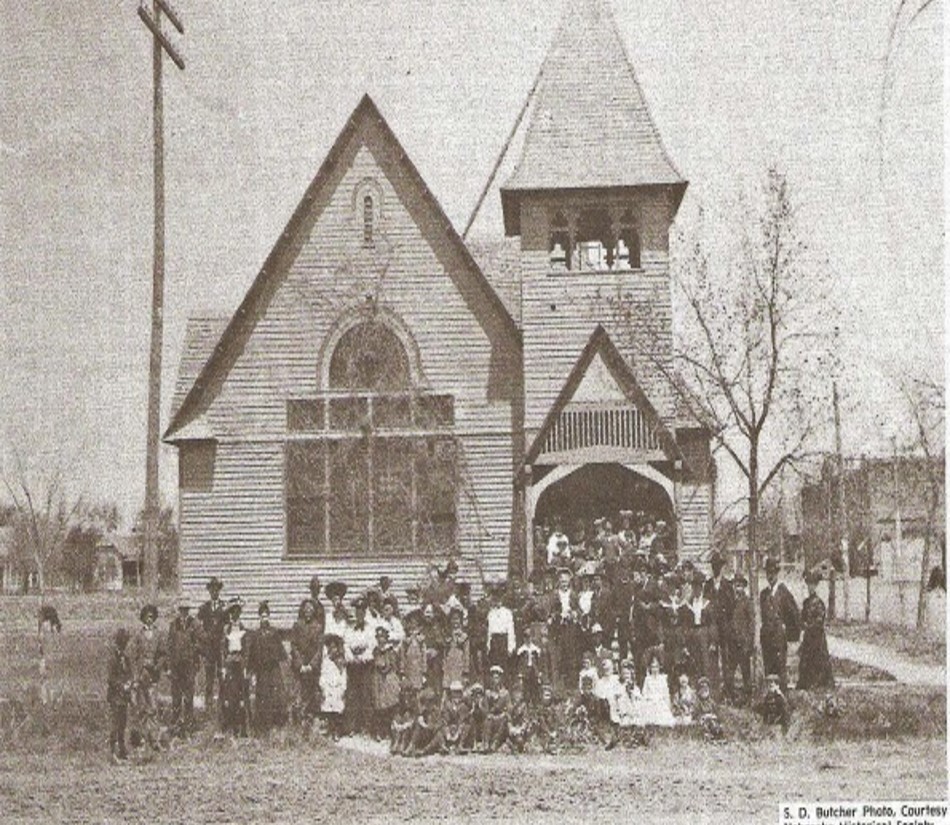
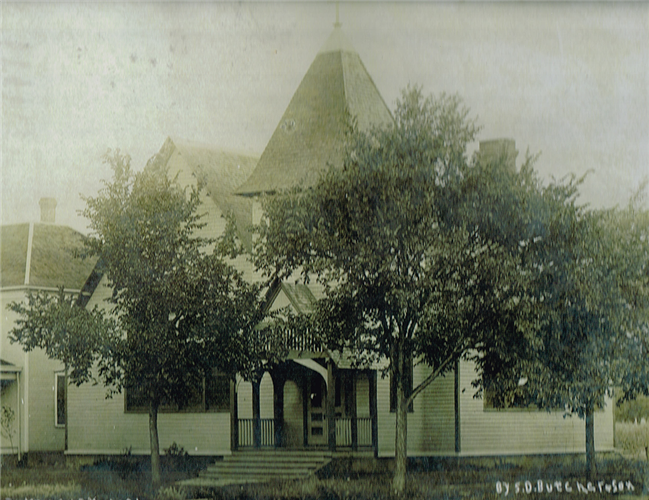
In 1884 property was purchased at 26th Street and Sixth Avenue and work was begun on a new church under Father Hork. Because of financial limitations the basement was roofed and used for worship. Within the next several years a frame church and rectory were built. Lumber from the old church was recycled to build this new church and a nearby rectory. Times were difficult financially in the 1880s past the turn of the century but a vision for a beautiful and permanent St. James church remained in the pastors’ and parishioners’ prayers.
Father Eugene Geary was appointed pastor of Kearney on Sept. 1, 1890. Two years later, in 1892, Father James A. Bruen was made pastor, followed by Father John Fitzgerald a year later. Father Fitzgerald served until 1897 when he was succeeded by Father Patrick McGovern, who would later become the Bishop of Cheyenne. Father McGovern served the people of Kearney for almost two years when Father Charles Petlach was made pastor. He was followed in July 1902 by Father Thomas Haley.
In 1905 Father F.J. McCarthy purchased a Presbyterian church on the northwest corner of First Avenue and 24th Street. The physical aspects of the Catholic Church in Kearney at that site were done by Father F. M. McCarthy. The properties were purchased March 31 and April 24 and a rectory was built next to the church by Father McCarthy in 1905. Late in 1906, Father Michael Daly was named pastor of St. James. With guidance of Father Daly, plans were made for a new church in 1908. Father Michael Daly planned to build a new church – large enough for 500 people, and of a grand Romanesque design. When that church was completed in 1911, Father Henry Muensterman was pastor. Note the old church in the background. It was used for the nun’s convent for a time. 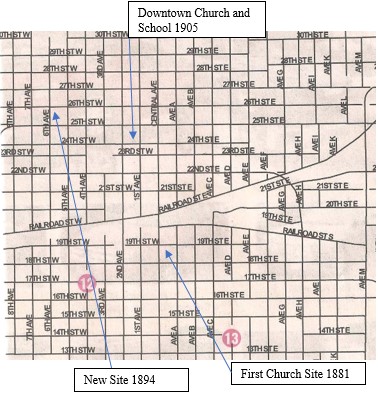
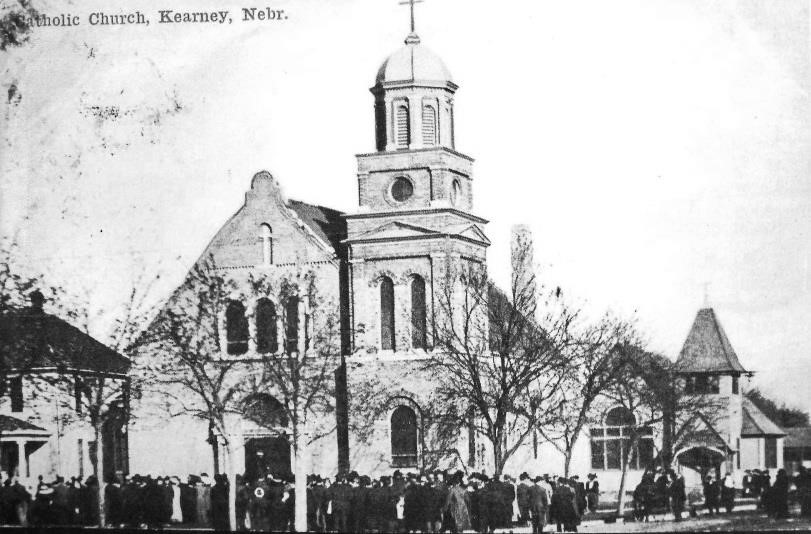

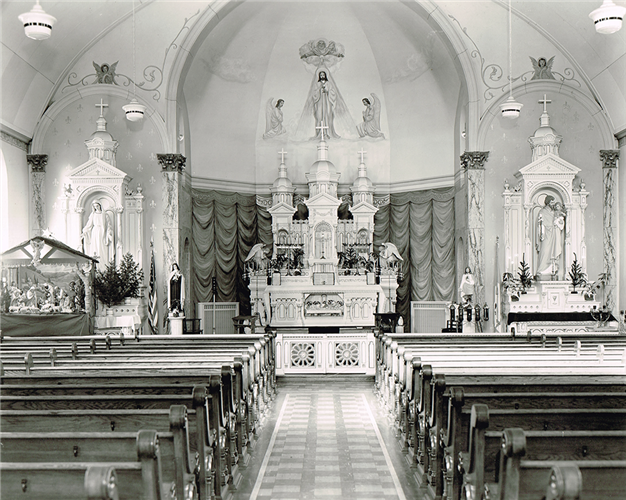
.jpg?ver=07YD6T5z7Yvvh0tbfdhTjQ%3d%3d×tamp=1634581152261)
On March 8, 1912, a diocese was created for northwestern Nebraska and Kearney was chosen as the See City and residence of the bishop. Rev. James A. Duffy became the first Bishop of Kearney. He was installed in the St. James Cathedral in Kearney on April 24, 1913. Kearney remained as the See of the Diocese until April 17, 1917, when Grand Island was made the See City by Pope Benedict XV. At that time Kearney had only 65 Catholic families, not all of them practicing Catholics.
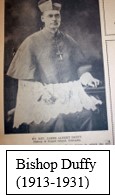
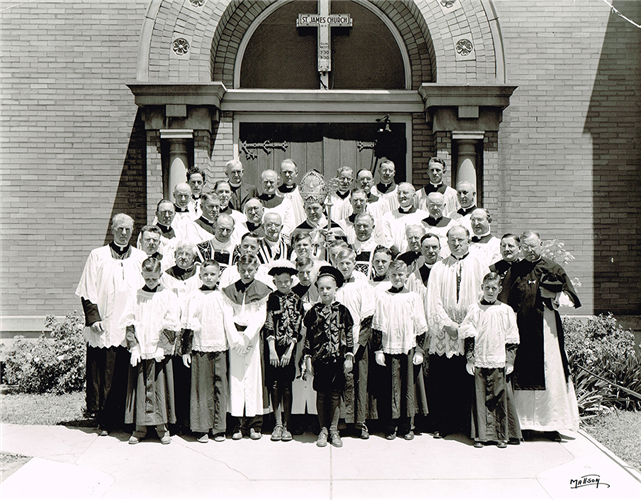
On Dec 30, 1914, at the instigation of Bishop Duffy, St. James purchased the three lots on th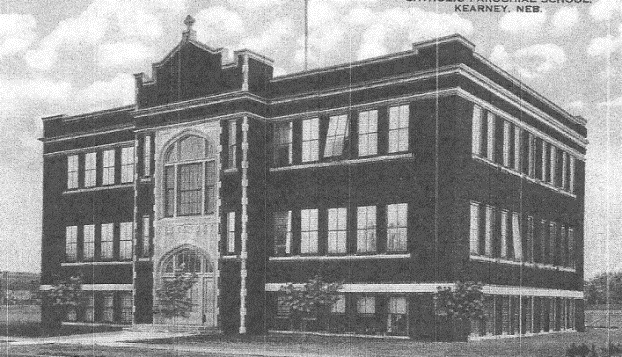 e southwest corner of 25th Street and 2nd Avenue. Plans were then made for a new school to be built on these properties. With the aid of $10,000 from the Catholic Church Extension Society of Chicago, the school was completed and dedicated in September, 1915. The school was staffed and operated by the Dominican Sisters of St. Catherine in Kentucky.
e southwest corner of 25th Street and 2nd Avenue. Plans were then made for a new school to be built on these properties. With the aid of $10,000 from the Catholic Church Extension Society of Chicago, the school was completed and dedicated in September, 1915. The school was staffed and operated by the Dominican Sisters of St. Catherine in Kentucky.
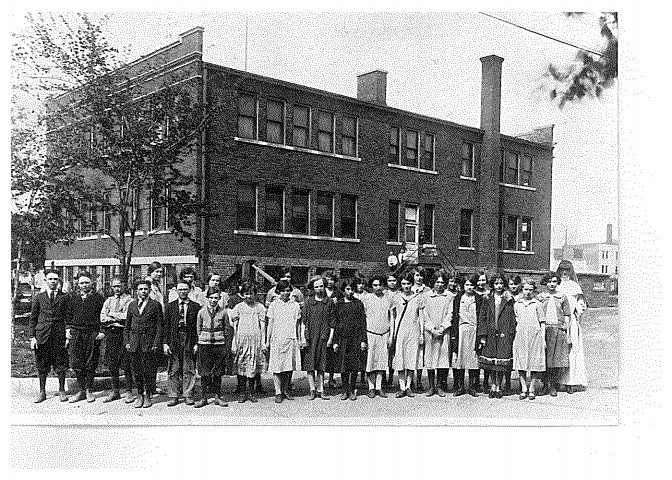
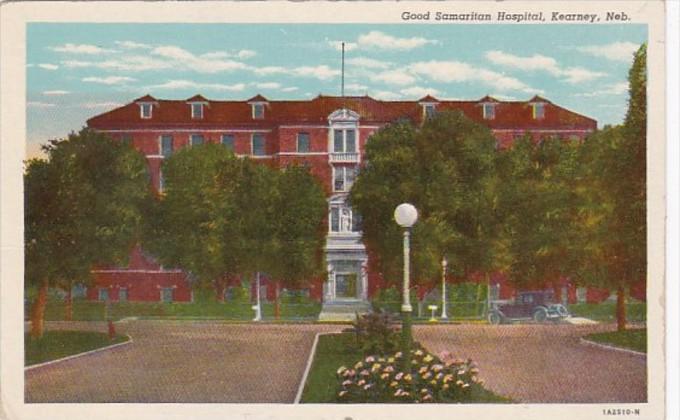 Good Samaritan Hospital was established in Kearney in 1924 by the Sisters of St. Francis of Lafayette, Ind. Francis G. Keens and his wife contributed $25,000 for the addition of a fourth floor of the hospital. He also donated an apartment building to the Carmelite Sisters to be used as a home for the aged. The Francis G. Keens Home for the aged was opened in 1929. (Mount Carmel Nursing Home was originally named Keens Home)
Good Samaritan Hospital was established in Kearney in 1924 by the Sisters of St. Francis of Lafayette, Ind. Francis G. Keens and his wife contributed $25,000 for the addition of a fourth floor of the hospital. He also donated an apartment building to the Carmelite Sisters to be used as a home for the aged. The Francis G. Keens Home for the aged was opened in 1929. (Mount Carmel Nursing Home was originally named Keens Home)
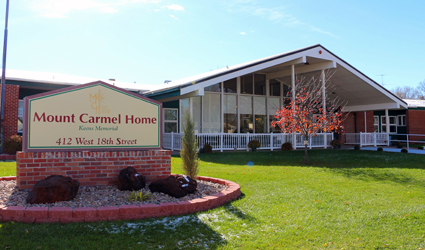
During the 1930s-1950s the Catholic community continued to grow. Father Muenstermann remained pastor until Aug. 15, 1938. On Aug. 27, 1938, Father Francis J. Tschida was named pastor and was installed Sept. 11, 1938. Father Tsc.jpg?ver=fqFa3G6ZRXdtPQIJbQdC5Q%3d%3d×tamp=1634585085180) hida was made a domestic prelate in 1951, and was appointed as Vicar General of the diocese. On April 2, 1953, Monsignor Tschida purchased additional property on 24th Street adjoining the parish property for $10,055. He served the parish as pastor until his death in December of 1956.
hida was made a domestic prelate in 1951, and was appointed as Vicar General of the diocese. On April 2, 1953, Monsignor Tschida purchased additional property on 24th Street adjoining the parish property for $10,055. He served the parish as pastor until his death in December of 1956.
After the death of Monsignor Tschida, Bishop Paschang appointed Father Raymond Miles pastor of St. James parish on Feb.1, 1957. That same month the parish purchased 60 acres of land at 35th street and Avenue A for the city’s first Catholic high school. The church and existing school were remodeled, and a convent was developed for the school’s Dominican sisters at 24th Street and Second Avenue. Construction on the new Catholic high school began in July of 1960: seventh through 10th grades, with the intention of adding a grade each year as the highest class neared graduation. September of 1961 marked the opening of the first Catholic high school in Kearney. Kearney Catholic High School was officially dedicated Oct.18, 1961 by Bishop John L. Paschang.
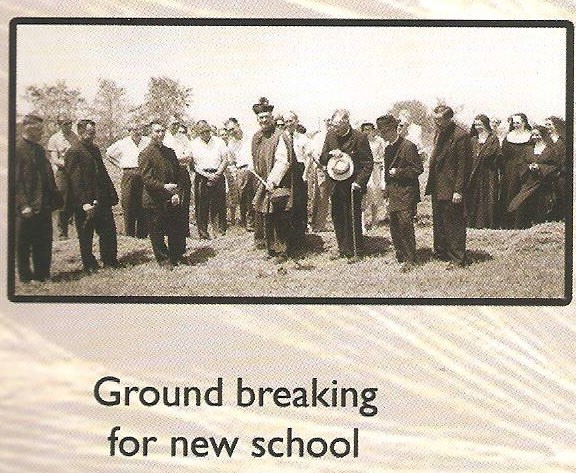
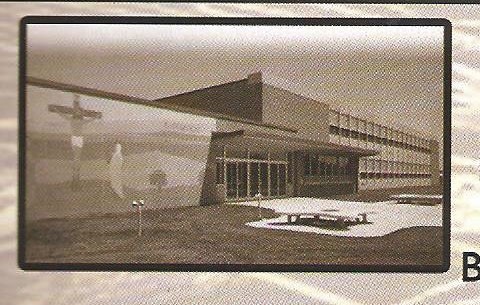
Father Eamon O'Dowd served the parish from 1970 to 1975 and was followed by Father Robert Chamberlain.
As the parish family and the Kearney community grew, the present church became over-crowded, not only “people-wise:” but also for parking. The downtown St. James Church, though architecturally beautiful and structurally sound, needed extensive reviving. The basement needed to be excavated and the restrooms needed to be installed. The building with only one major entrance and exit, constituted a major fire hazard. Parking space and seating space was inadequate.
In planning for the new facilities, it was felt that the parish had a need for a center to take care of the many needs of the parish; meeting rooms, counseling rooms, nursery, office area for the parish business and a social room for many other needs. The new church in 1980 was to seat 640 people with the front foyer and a courtyard.
In 1977 plans to build materialized. Two sites were under consideration by the planning and building committee: 46th Street and Avenue C, and 3801 Ave. A, just north of Kearney Catholic. The site on Avenue A was chosen. Plans for the new church came to some $750,000, not including carpet, sound, pews, the organ, windows or the parking lot; and a fund-raising drive commenced for $600,000. The former church and school was sold for $300,000, and another $100,000 from the sale of church and school artifacts, and $640,000 was pledged during the capital campaign. Additional donations funded the carpet, sound, organ and other interior items needed for the New St. James.
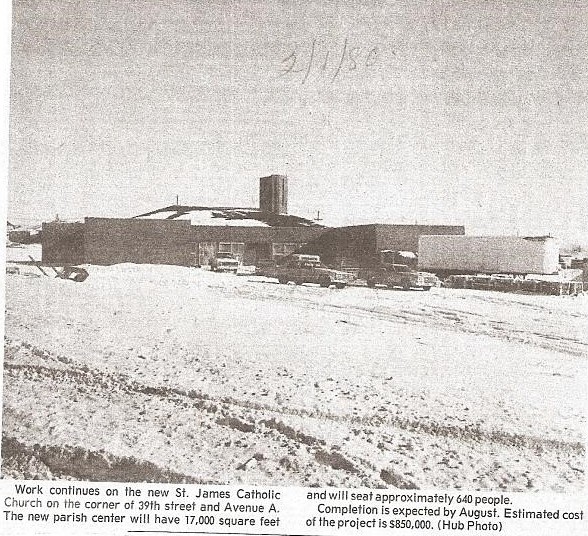
Groundbreaking was held on June 11, 1979.
Approximately 300 people attended.
To commemorate the move to the new parish center, there was a procession from the downtown facilities to Kearney Catholic High School on July 24, 1980. The Tabernacle, church bell and other religious articles were carried in this procession. Transportation was provided for the elderly and those unable to walk. There were no cars in the procession. 
Dedication was on Friday, July 25, 1980, on the Feast of St. James the Greater.
The dedication was at 6:30 PM with Bishop Lawrence J. McNamara presiding.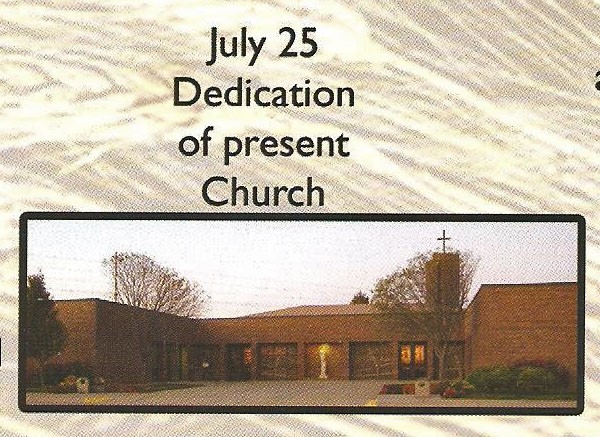
This was followed by a meal served on the football field of Kearney Catholic High School adjacent to the new parish center. The old St. James Church and its rectory at 24th Street and First Avenue were sold and today, the former St. James Church is used as office space.
At the time of the building of the new parish center, the parish bought a house at #7 Sioux Lane and remodeled it to accommodate at least 2 priests. Property was also purchased at 3415 Avenue B to build a four apartment convent. The cost of the convent was $54,000.
Father Chamberlain continued to serve the parish until 1982 when Father James O'Kane was appointed, serving until 1989. During his pastorate, St. John Capistran in Amherst became a mission of St. James until 1994 when it became a mission of Elm Creek.
After we settled into our new environment in 1980, the priests decided that we were such a large population that we needed to do some activities to get to know each other. With over 1400 families this was not an easy task.
St. James Fellowship Dinners with Speakers were hosted at the, then, Ramada Inn to bring the adults together for an evening of togetherness and fun. Often the KCHS music groups would perform for these.
Octoberfest was started to serve all and create the atmosphere of wholeness. Tithing of 10% of the proceeds goes to charity that the Parish Council decides is important. At one point the Celebrate Singers came to Kearney on that weekend and performed at church as well as during the festival. Many of the congregation families were asked to host this group for the weekend.
These activities took many parishioners to complete this task.
Some of the Octoberfest activities consisted of a dinner with a silent auction and a live auction as well as a Bake Sale, Bingo, Craft Sale, Raffle, and Kid Games.
We have continued to celebrate the Feast of St. James every July. Many years we had the festival on the football field with food, games, etc. When asking some of the youth, who are adults now, they do remember those get-togethers.
In 1984, the Knights of Columbus, Kearney Council 1828, presented the idea to build a bell 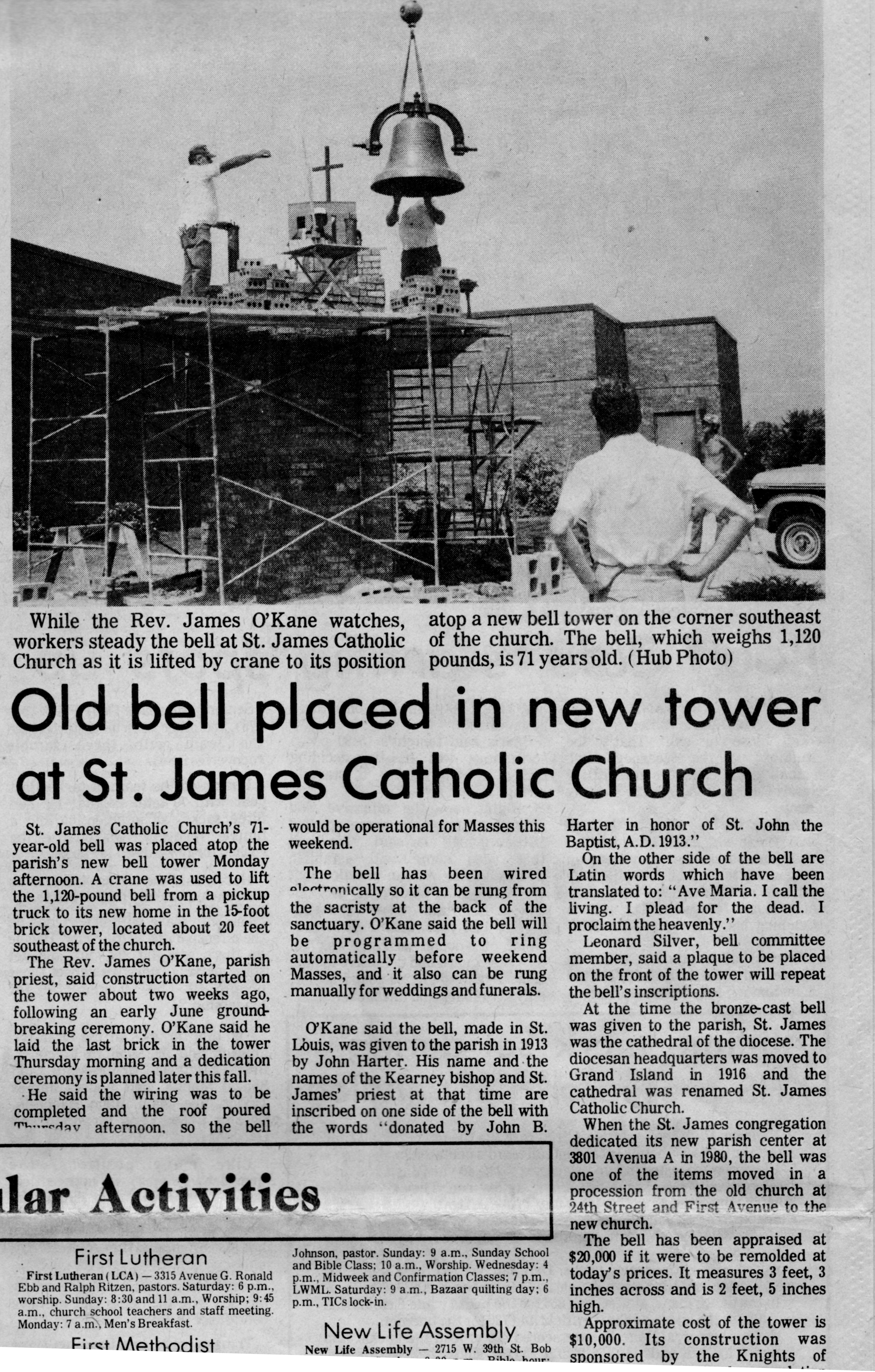 tower to hold the bell from the old St. James church. This is the bell that tolled at St. James Cathedral of Kearney from 1912-1916, and in Kearney's St. James Church from 1916-1980. The bell was moved from the downtown church to the present church in the processional parade in 1980. The groundbreaking was held in June 1984 and Father James O'Kane laid the last brick on the tower 2 weeks later and the bell was lowered into place. On September 9, 1984 dedication was held for the newly installed bell tower.
tower to hold the bell from the old St. James church. This is the bell that tolled at St. James Cathedral of Kearney from 1912-1916, and in Kearney's St. James Church from 1916-1980. The bell was moved from the downtown church to the present church in the processional parade in 1980. The groundbreaking was held in June 1984 and Father James O'Kane laid the last brick on the tower 2 weeks later and the bell was lowered into place. On September 9, 1984 dedication was held for the newly installed bell tower.
The bell was originally presented to St. James in 1913 by John Harter. The names of the Kearney Bishop and St. James priests at that time were inscribed on one side of the bell. 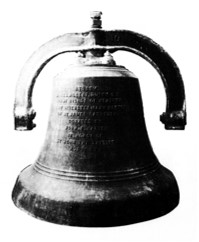 The other side of the bell, the Latin words which have been translated to: "Ave Maria. I call the living. I plead for the dead. I proclaim the heavenly." A plaque was placed in front of the tower repeating the bell's inscription.
The other side of the bell, the Latin words which have been translated to: "Ave Maria. I call the living. I plead for the dead. I proclaim the heavenly." A plaque was placed in front of the tower repeating the bell's inscription.

The project was undertaken by the committee of Knights: Lawrence Richter, Lambert Larchick, Leonard Silver, and James Richter.
In 1985, as part of the 25th anniversary of Kearney Catholic High School, the Kearney Catholic High School Foundation had a development campaign fund drive to help ensure the continuation of Kearney Catholic High School. The foundation was organized in 1981 with a permanent endowment fund designed to provide supplemental funding for Kearney Catholic High School. The campaign met their goal of $500,000.
In August 1985, Bishop Lawrence McNamara of the Grand Island diocese announced a second Catholic Parish in Kearney, Prince of Peace. Dividing lines were established and our number of members were reduced. Prince of Peace parish was born with 375 families and pastor Father Jack Schlaf in 1986.
In 1986 the St. James Parish approved a new constitution which updates and meets the needs of the parish. The parish also reintroduced the tithing program. As a result of the tithing program, many blessings have been received by the people of the parish.
Father Ted Nekoliczak was appointed pastor in 1989 serving until Father Charles Torpey was appointed in 1996.
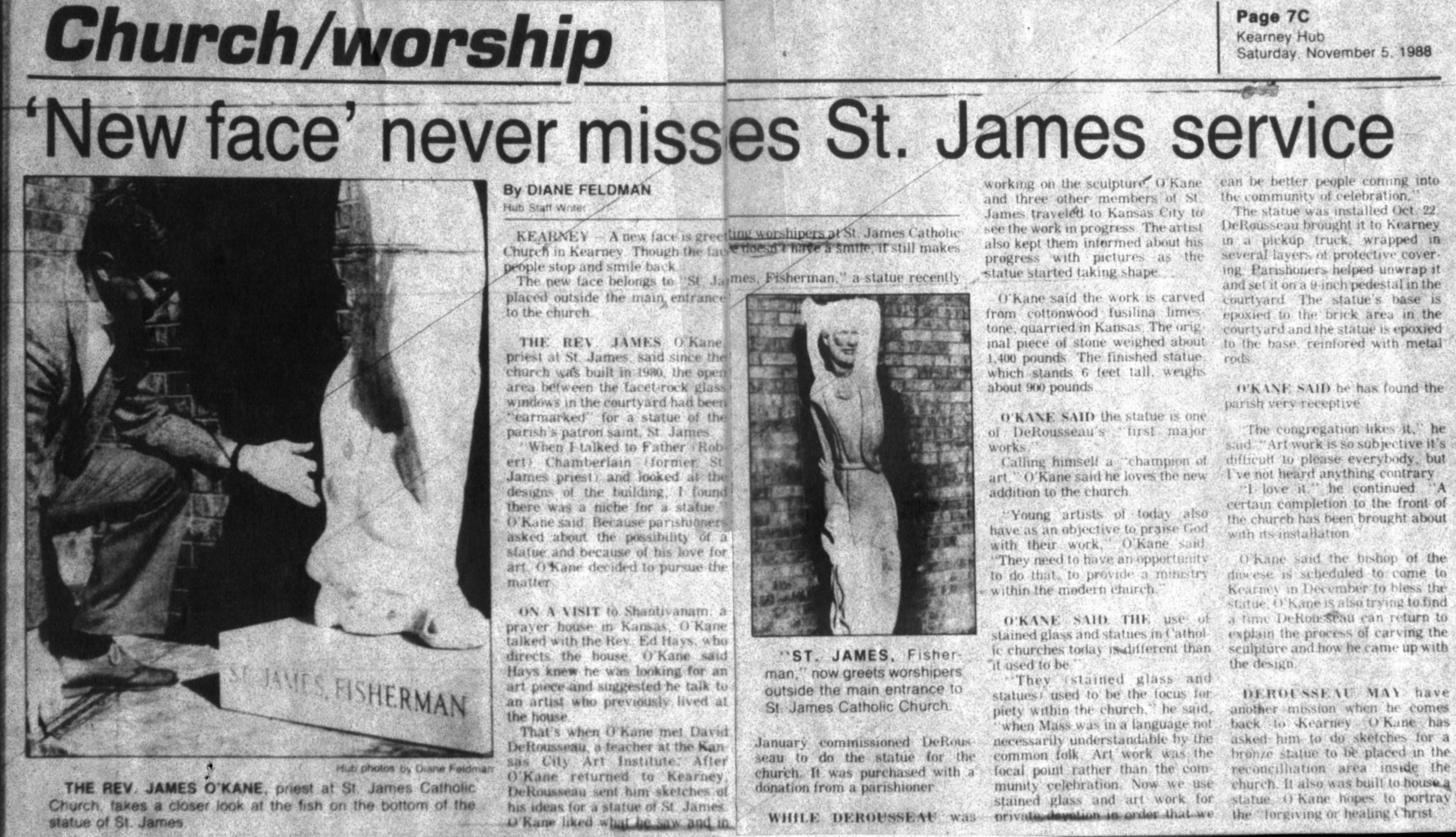
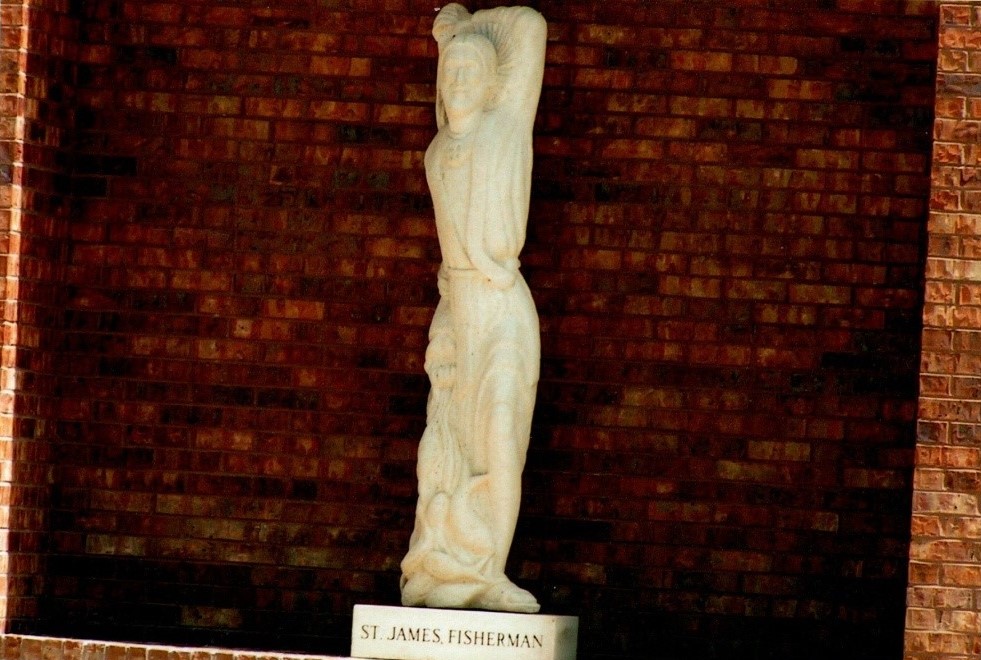
In the summer of 1989, St. James commissioned and received a bronze casting, "The Forgiving Christ with Mary Magdalene", which is placed at the entrance to the Reconcilliation Chappel.
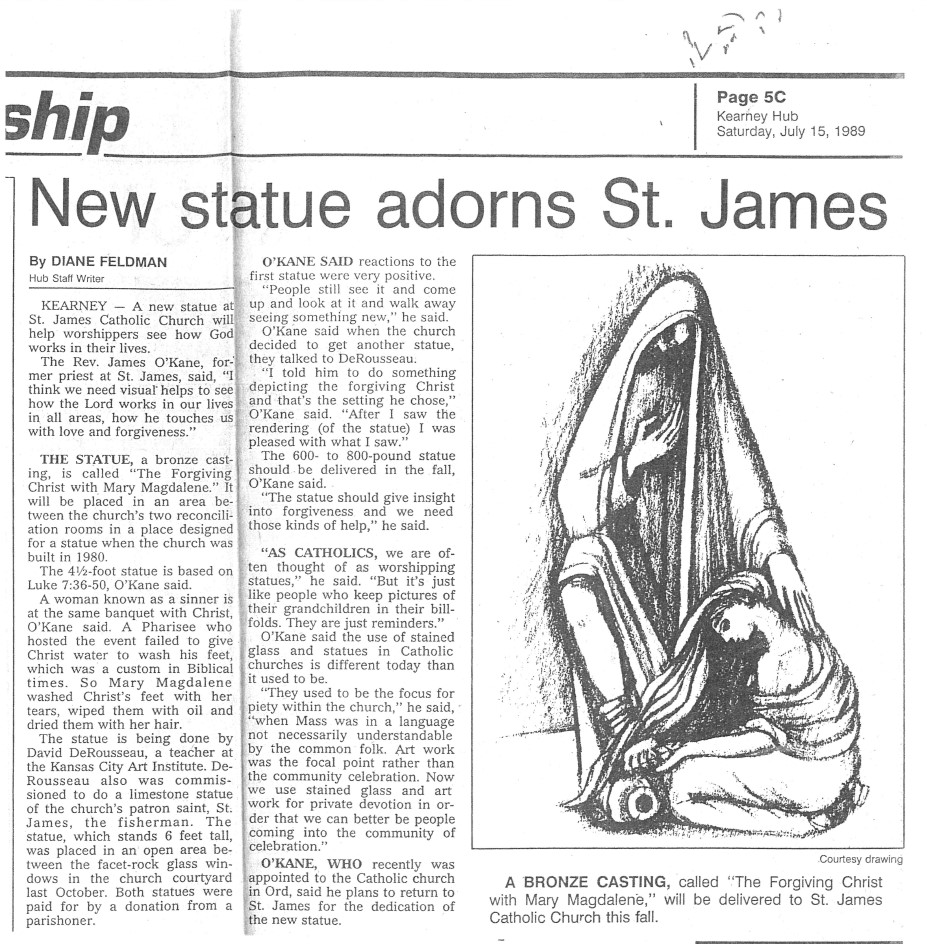
In July, 1994, St. James was privileged to have Father Jim Golka as Associate Pastor for his first assignment after ordination. On June 29, 2021 Father Golka was installed as the third Bishop of the Diocese of Colorado Springs.
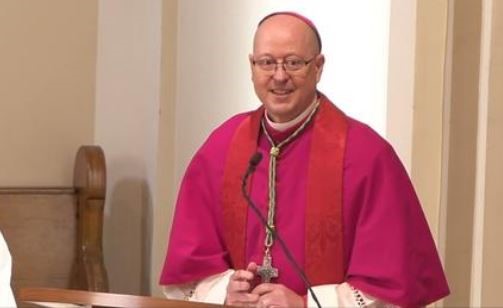
In 1996 St. James begun to add to their existing building a parish hall, youth area, kitchen, nursery and daily chapel. All of the building and direction up to this point had been guided by Father Robert Chamberlain, Father James O’Kane, Father Ted Nekoliczak and Father Charles Torpey.
The building process and change continued—
In 2008 the Catholic Community raised $5.5 million to build a new Prince of Peace Catholic church and to make improvements to St. James. With the new Prince of Peace new dividing lines were established and our population shifted again.
Father Joseph Hannappel was appointed pastor in 2009 and Father Joshua Brown was assigned associate pastor of St. James in 2010.
A Facilities Improvement Planning Team was commissioned in November 2012.
From the work of this team and sub teams as well as a survey of the parishioners, a vision was developed and priorities were set to enhance the future of St. James. These priorities were to create a larger gathering space, enlarge the worship space, improve lighting in the worship space, add spaces for families, remodel parish offices and update the physical plant. The renovation began April 12, 2015. During that time Mass was celebrated at Prince of Peace Church and Kearney Catholic High School as well as the use of the Merryman Center, and Harmon Park.
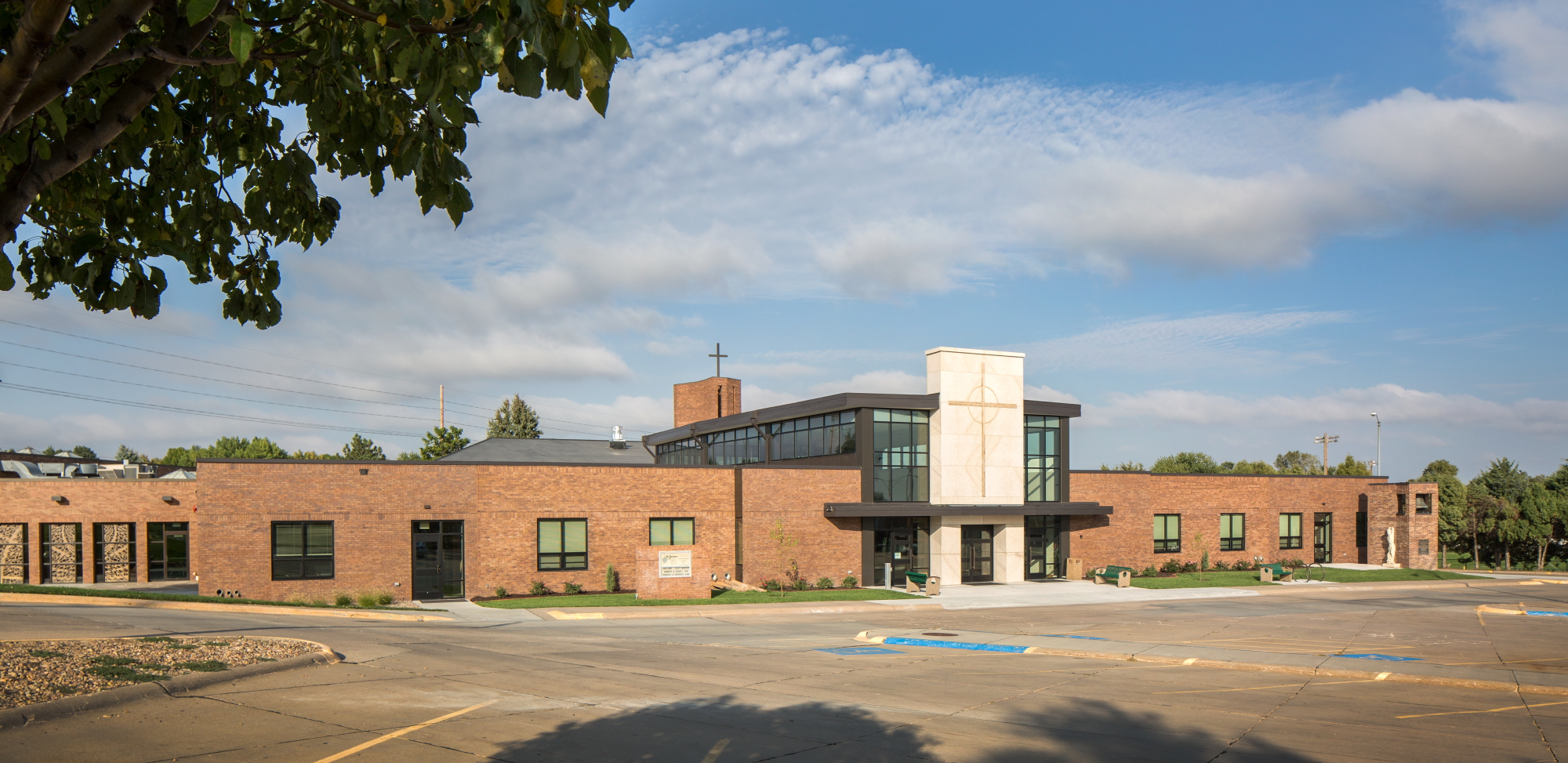
On April 2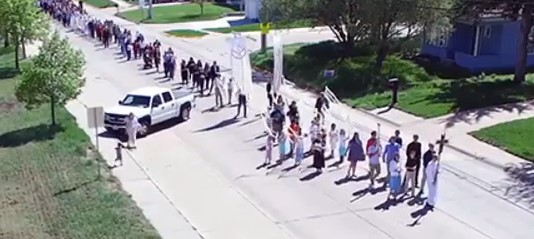 4, 2016 the space was dedicated with a procession from Kearney Catholic High School to the church. Video of the procession.
4, 2016 the space was dedicated with a procession from Kearney Catholic High School to the church. Video of the procession.
Our way of worship was altered dramatically beginning in 2020 as a result of the Covid-19 pandemic. No longer was Mass celebrated in person. There was no public celebration of Easter. Mass was live streamed on YouTube. St. James was fortunate to purchase new video equipment to better stream services.
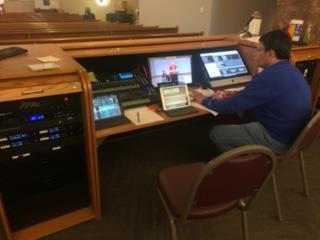
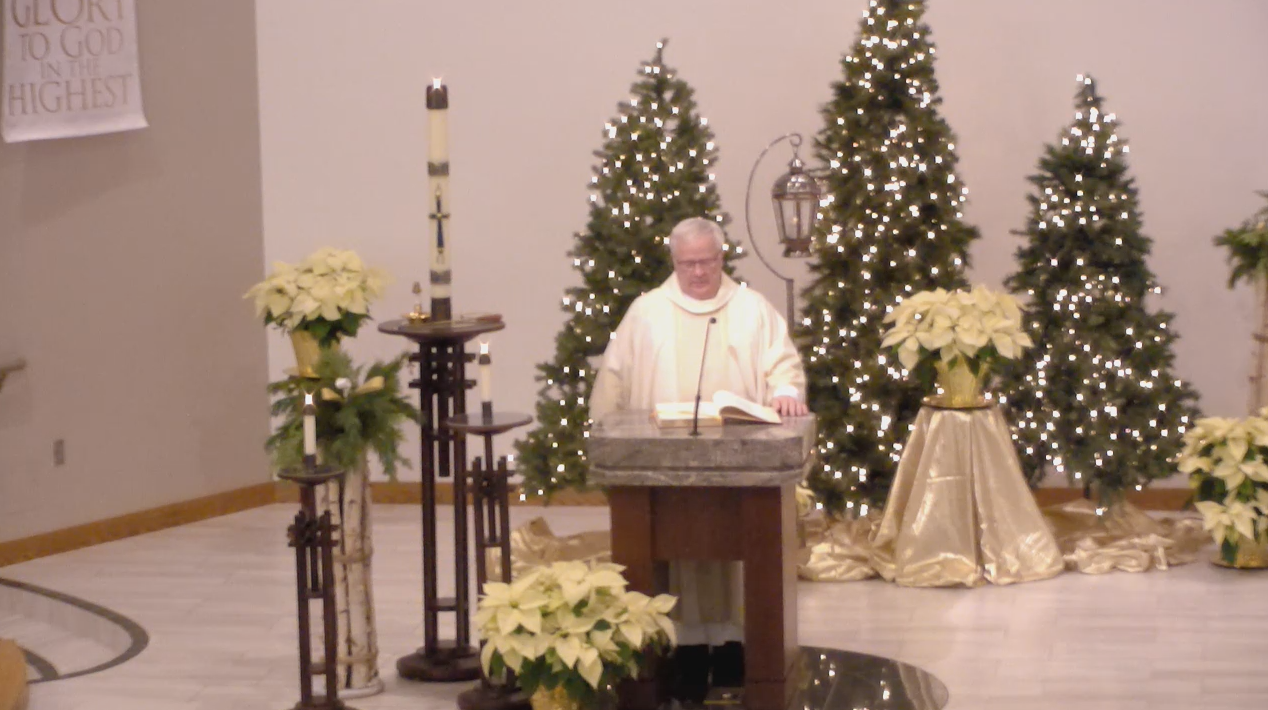
As the situation dictated, parishioners were gradually allowed to worship in the church. Christmas 2020 was celebrated in person with recommended pandemic precautions. The Christmas Eve Mass of 2020 was the first to be recorded live and replayed on NTV Christmas Day.
The mortgage on the 2015- 2016 renovation was paid off in 2021. The celebration for burning the mortgage was during the 2021 Feast of St. James.
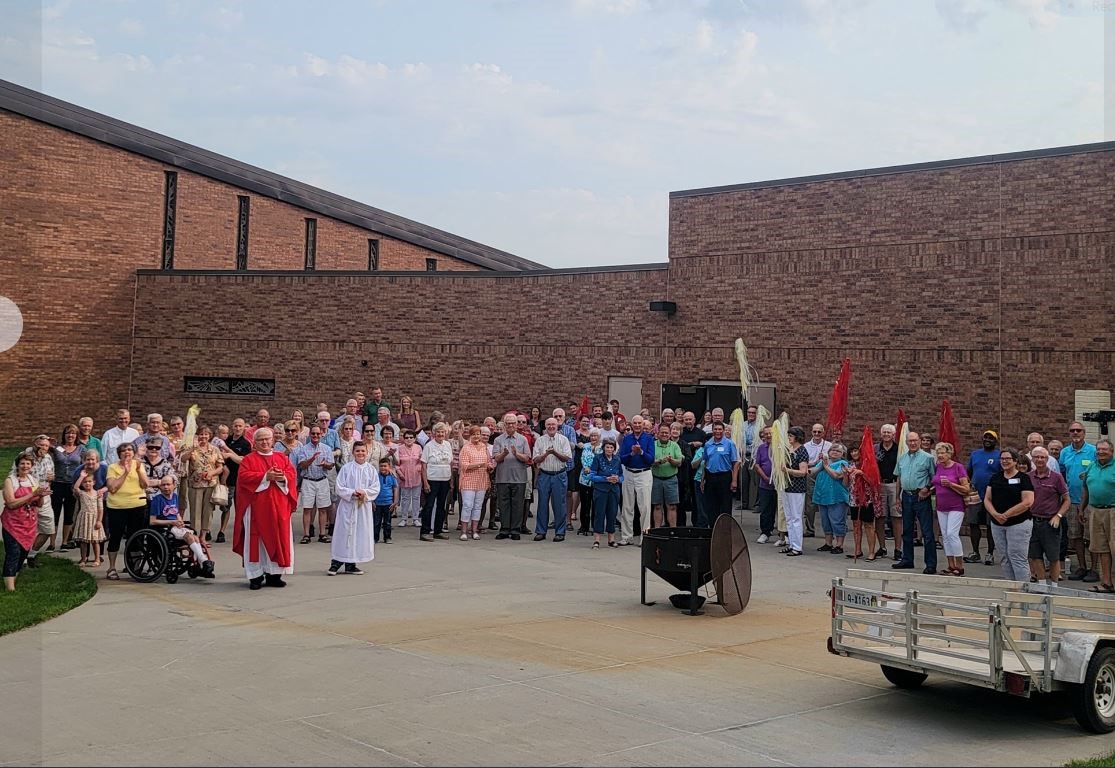
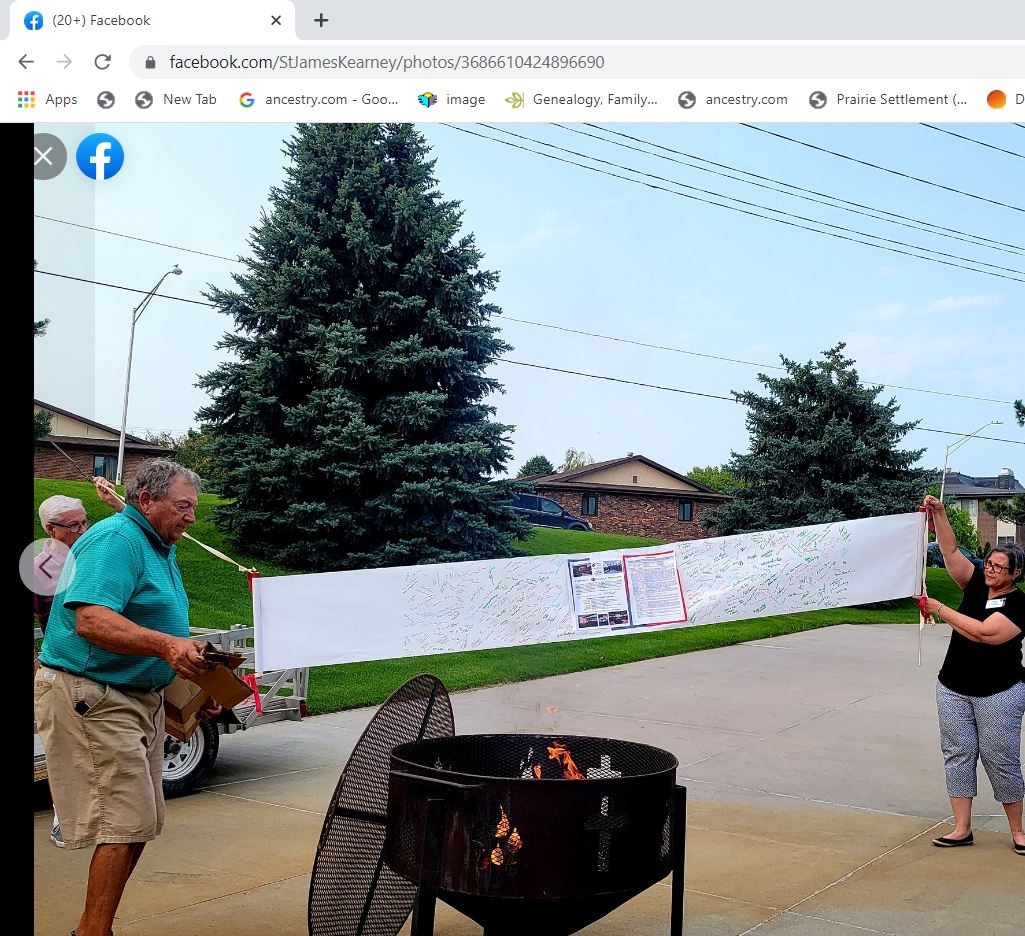
November 2022 marked the completion of a new monument sign at the corner of 39th Street and A Avenue. A new water feature in the prayer garden was also completed in November of 2022.
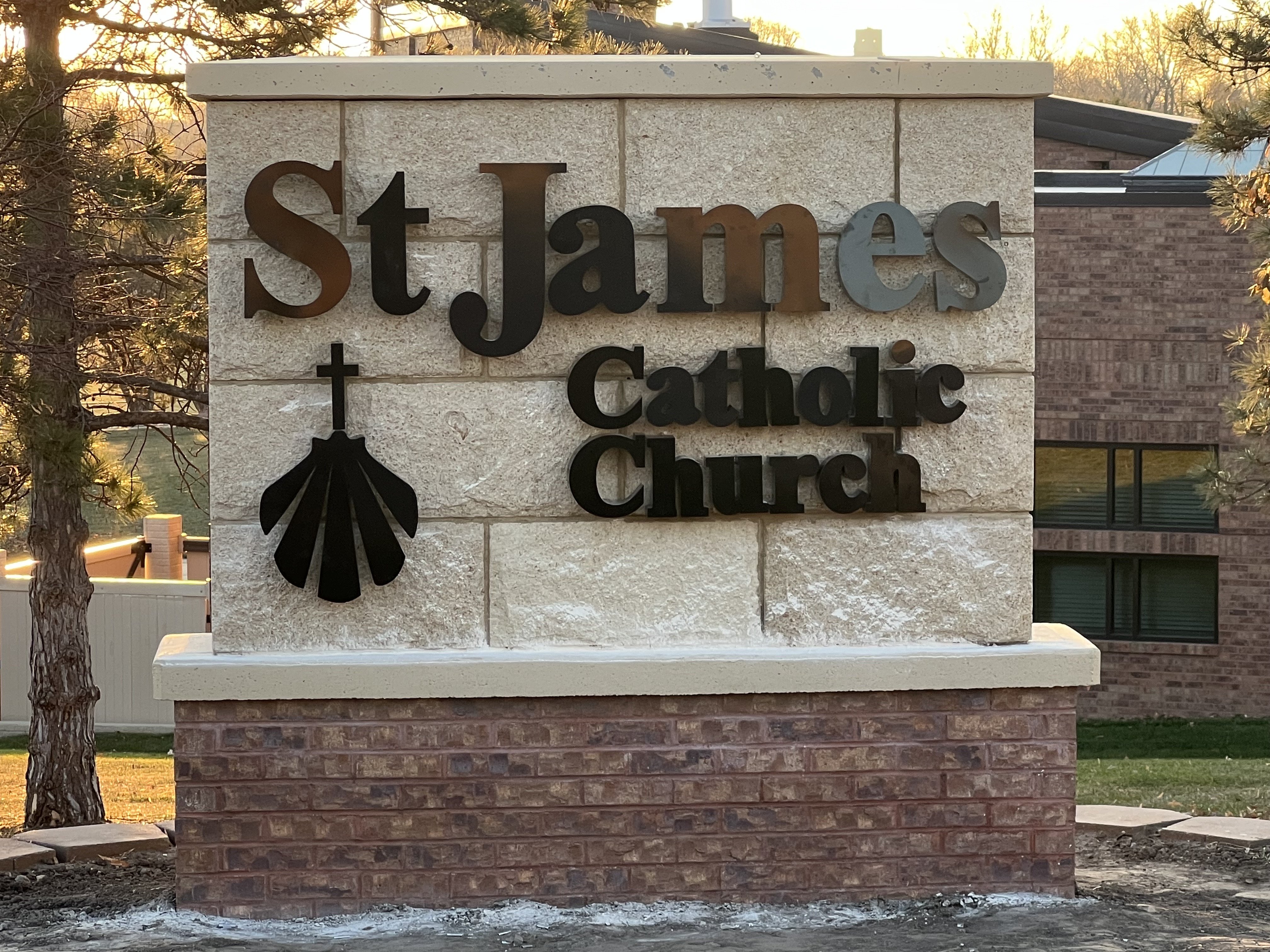
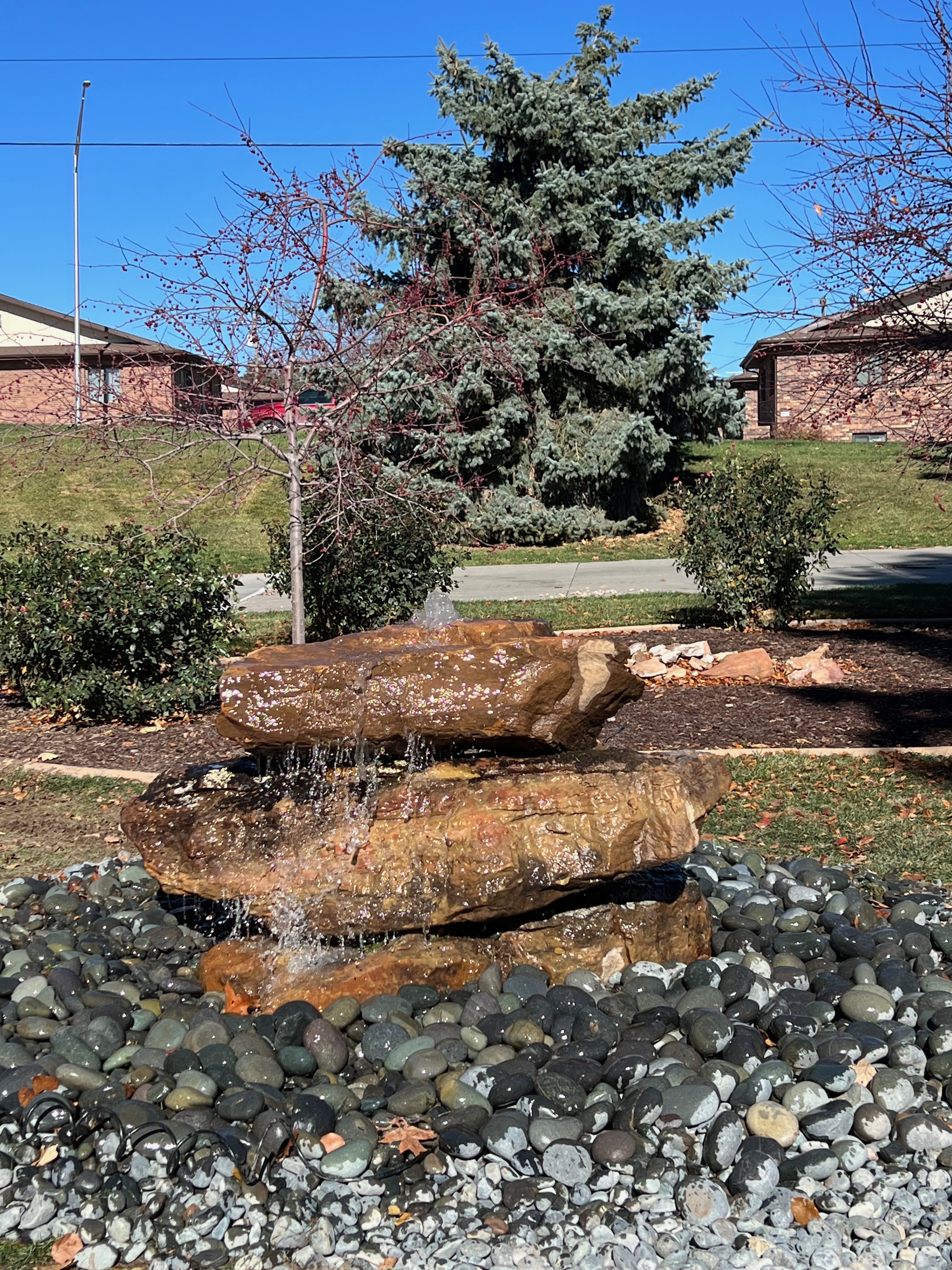
In memory of Mary Kalb, a statue of The Holy Family was commissioned. It was hand crafted in Italy by Master Artisans of Demetz Art Studio and placed in Mary's Playground in the summer of 2024.
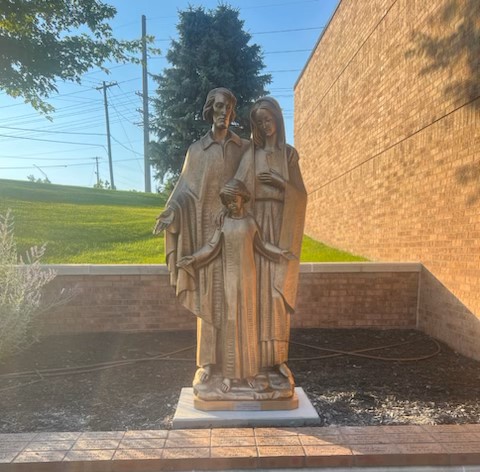
- Compiled from writings by Father John F. Scott,1962; Anne Elliott, 1979; Elaine Batenhorst, 2021; Web Site Ron Dobesh 2022